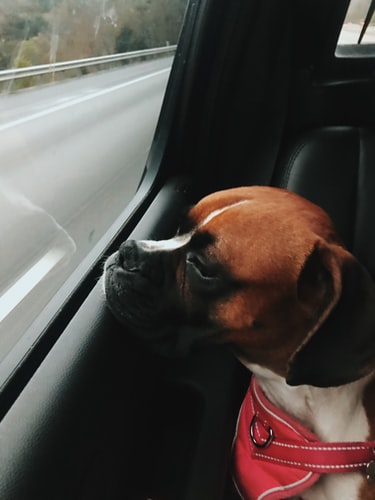If you’re an enthusiastic dog parent who loves to drive, there are probably few things you want to share with your fur baby more than the feeling of being on the open road. However, you can’t expect your pup to be your co-pilot from the start, as dogs don’t take too well to being confined in enclosed spaces for too long. They also have special travel needs that you’ll need to address before you can take them on any kind of extended trip in a car. With a bit of patience and thoughtful preparation, though, your furry pal can become a most excellent traveling companion. Here’s how to get your favorite four-legged friend used to riding in a car with you:
Prepare Your Car for Traveling with Your Dog
One of the easiest ways to start teaching your dog to love your car is to make being in it a happy and comfortable experience for them. Put simply, you want your vehicle to feel like it’s an extension of your home.
To do this, consider familiarizing them with a number of customizable pet products like blankets and chew toys. Afterward, you can put these items in the back of your car on your next trip. These will help provide emotional comfort and hopefully lower your pet’s anxiety to a more manageable level.
While you’re at it, consider getting your pet a seatbelt of their own or a harness that can be used with your vehicle’s existing seatbelt setup. Allowing your pet to run loose and unrestrained while in a moving vehicle can be incredibly dangerous, not just for them and your other passengers but also for you as the driver. Strapping them in prevents them from sticking their head out the window where they could get struck by something, as well as from jumping out when you’re not looking.
Prepare Your Dog for Traveling in Your Car
For pups that need a bit more calming and reassurance, you can try a training technique called desensitizing. It involves familiarizing them with your vehicle slowly, in stages that will eventually condition them into thinking of your car as a place where good things happen.
Start by putting your pet in the backseat of your car, closing the door, and standing outside for a few minutes. Once they’ve calmed and quieted down, give them a treat and let them out of the vehicle.
After they’ve gotten used to this routine, you can progress to putting them in the back of the car and getting into the driver’s seat. Shower your pet with praise while starting the engine and wait for a few minutes. Then, turn the engine off, exit the car, and give your pet a treat before letting them out. Before long, you should be able to take them on short car trips down the street or to the park without a fuss.
Another way to desensitize your pet is to make certain changes to their mealtime routine. Start setting their food bowl out near the vehicle and having them take their meals there for a few days. Once they’re used to that, start feeding them in the backseat of your car with the door open. Between meals, you can toss them treats by the open car door or play games within the vicinity of the vehicle. Just make sure that it’s safely parked away from the street before doing so.
Crate Train Your Dog
Breeders and veterinarians alike recommend crate training your dog for a plethora of good reasons, some of which can be very beneficial while traveling. As you know, the unfamiliar sights and sounds of a new place can stress your dog out. Traveling with them safely settled inside of their crate can make for a safer, more relaxing journey all around.
Crate training your dog can also minimize the number of spills and accidents you’ll have to clean up while en route to your destination. Because dogs are den animals, they won’t want to soil where they sleep and will hold their bladder while in their crate.
Crate training can take days or weeks, so it’s always best to start early. Put a soft blanket or towel that your dog already uses inside of the crate, take the door off, and allow them to explore it at their leisure. You can encourage them to use the crate with treats, but never force them inside of it. Once they’ve gotten used to the space, you can begin to feed them meals in the crate with the door closed. Then, make each training session a little bit longer than the last. Before you know it, you should be able to take both pet and crate with you on your next extended road trip.
Taking your pup on a car trip isn’t as much of a challenge today as it used to be. With a bit of foresight and preparation, you, too, can start taking your dog everywhere with you.
